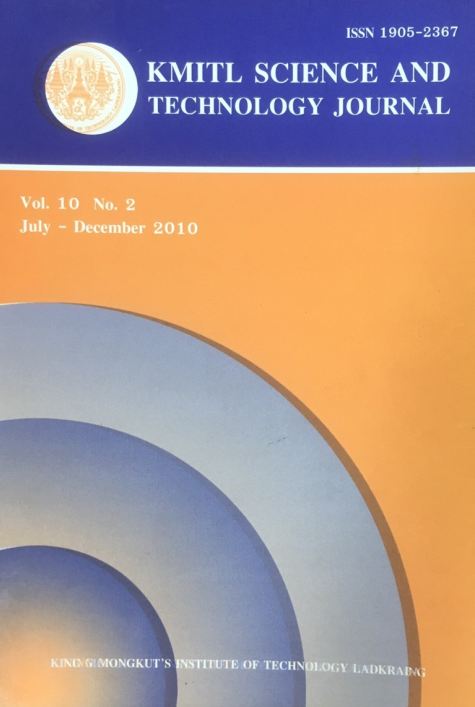Biocontrol Efficacy of Bacillus subtilis BCB3-19 against Tomato Gray Mold
Main Article Content
Abstract
The soil bacterium, BCB3-19, isolated from rhizosphere of tomato and identified as Bacillus subtilis was evaluated for biocontrol activities against Botrytis cinerea, a phytopathogenic fungus causing gray mold rot of tomatoes after harvest. In vitro assay by co-culture of BCB3-19 and B. cinerea on agar plates showed that the bacterium effectively inhibited radial growth of the fungus at 4° C and 23°C. In vivo evaluation on tomato fruits showed that the bacterium effectively suppressed the development of gray mold at 4°C and 23°C. The population dynamic study showed that the bacterium successfully colonized tomato fruits. Population of the bacterium was continually increasing at 23°C but was static at 4°C. The bacterium did not exhibit hemolytic and lecithinase activities. These findings support the potential use of Bacillus subtilis BCB3-19 for biological control of postharvest tomatoes against B. cinerea.
Keywords: Bacillus subtilis, Botrytis cinerea, Biocontrol, tomato
E-mail: sirirat2@yahoo.com
Article Details
Copyright Transfer Statement
The copyright of this article is transferred to Current Applied Science and Technology journal with effect if and when the article is accepted for publication. The copyright transfer covers the exclusive right to reproduce and distribute the article, including reprints, translations, photographic reproductions, electronic form (offline, online) or any other reproductions of similar nature.
The author warrants that this contribution is original and that he/she has full power to make this grant. The author signs for and accepts responsibility for releasing this material on behalf of any and all co-authors.
Here is the link for download: Copyright transfer form.pdf
References
[2] Stein, T., Borchert, S., Conrad, B., Feesche, J., Hofemeister, B., Hofemeister, J. and Entian,K. D. 2002. Two different antibiotic-like peptides originate from the ericin gene cluster of Bacillus subtilis A1/3. Journal of Bacteriology, 184, 1703-1711.
[3] Liu, Y. F., Chen, Z. Y., Ng, T. B., Zhang, J., Zhou, M. G., Song, F. P. and Liu, Y. Z. 2006. Bacisubin, an antifungal protein with ribonuclease and hemagglutinating activities from Bacillus subtilis strain B-916. Peptides 28:553-559
[4] Grover, M., Nain, L., Singh, S. B. and Saxena, A. K. 2010. Molecular and biochemical approaches for characterization of antifungal trait of a potent biocontrol agent Bacillus subtilis RP24. Current Microbiology, 60, 99-106.
[5] Barbe, V., Cruveiller, S., Kunst, F., Lenoble, P., Meurice, G., Sekowska, A., Vallenet, D.,Wang, T., Moszer, I., Médigue, C. and Danchin, A. 2009. From a consortium sequence to a unified sequence: the Bacillus subtilis 168 reference genome a decade later. Microbiology,155, 1758-1775.
[6] Teo, A. Y. L. and Tan, H. M. 2005. Inhibition of Clostridium perfringens by a novel strain of Bacillus subtilis isolated from the gastrointestinal tracts of healthy chickens. Applied and Environmental Microbiology, 71, 4185-4190.
[7] Pinchuk, I. V., Bressollier, P., Verneuil, B., Fenet, B., Sorokulova, I.B., Mégraud, F. and Urdaci, M. C. 2001. In vitro anti-Helicobacter pylori activity of the probiotic strain Bacillus subtilis 3 is due to secretion of antibiotics. Antimicrobial Agents and Chemotherapy, 45,3156-3161.
[8] Sorokulova, I. B., Pinchuk, I. V., Denayrolles, M., Osipova, I. G., Huang, J. M., Cutting, S.M. and Urdaci, M. C. 2008. The safety of two Bacillus probiotic strains for human use.Digestive Diseases and Science, 53, 954-963.
[9] Bergey's Manual of Determinative Bacteriology 1994. Bergey’s Manual of Determinative Bacteriology. 9th ed. Baltimore: The Williams and Wilkins Company.
[10] Wang, S., Tongle H. U., Yanling J. I. A. O., Jianjian W. E. I. and Keqiang C. A. O. 2009.Isolation and characterization of Bacillus subtilis EB-28, an endophytic bacterium strain displaying biocontrol activity against Botrytis cinerea Pers. Frontiers of Agriculture in China, 3(3), 247-252.
[11] Weisburg, W. G., Barns, S. M., Pelletier, D. A. and Lane, D. J. 1991.16S ribosomal DNA amplification for phylogenetic study. Journal of Bacteriology, 173:697-703.
[12] Yamada, Y., Katsura, K., Kawasaki, H., Widyastuti, Y., Saono, S., Seki, T., Uchimura, T. and Komagata, K. 2000. Asia bogorensis gen. nov., an unusual acetic acid bacterium in the
α- Proteobacteria. International Journal of Systematic and Evolutionary Microbiology, 50,823-829.
[13] Gholamreza, D. N., Mohammadreza, H., BibiFazly Bazzaz, S. and Fazly, B. 2005. Isolation,characterization, and investigation of surface and hemolytic activities of a lipopeptide biosurfactant produced by Bacillus subtilis ATCC 6633. Journal of Microbiology, 43, 272-276.
[14] Liu, J., Fang, C., Jiang, Y. and Yan, R. 2009. Characterization of a hemolysin gene ytjA from Bacillus subtilis. Current Microbiology, 58, 642-647.


